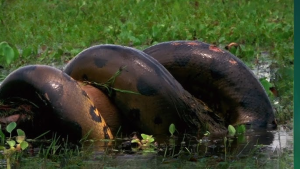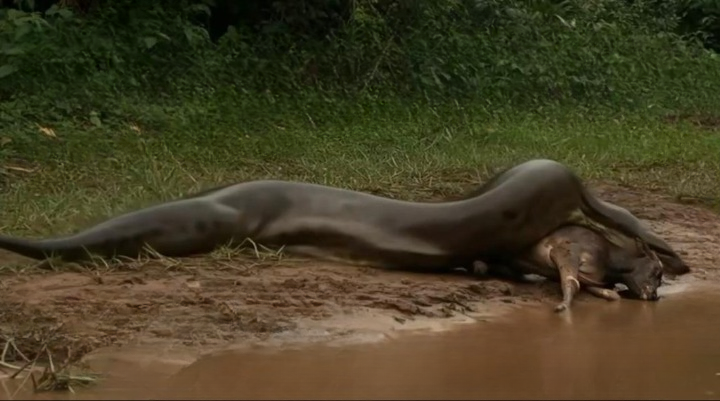The internet has become a space where shock, awe, and curiosity often collide. In the last decade, platforms like TikTok have turned brief, dramatic clips into global sensations overnight. Users scroll for entertainment, but what hooks them most are moments that seem too incredible to be true. Among the countless viral stories, one video gained particular attention: a supposed recording of the world’s largest anaconda devouring a horse whole.
From the instant it appeared online, the video sparked immediate debate. Some viewers were convinced they had witnessed undeniable proof of nature’s terrifying extremes. Others suspected digital manipulation or clever editing. Could a snake, even one as legendary as the green anaconda, realistically accomplish such a feat? Or was the clip just another internet myth designed to exploit humanity’s fascination with nature’s most dramatic predators?

As the footage spread across TikTok, Facebook, Instagram, and Twitter, conversations grew more intense. The short, grainy clip became more than entertainment; it evolved into a cultural phenomenon that pulled in scientists, herpetologists, wildlife enthusiasts, and everyday internet users. The debate forced the public to revisit what they knew—or thought they knew—about giant snakes.
This article unpacks the entire story. We’ll look closely at the biology of anacondas, the myths that surround them, the psychology behind viral media, and why human culture has always been obsessed with creatures larger than life.
The Clip That Shocked Millions
The video that caused global fascination was both brief and haunting. Promoted with titles like “The Largest Snake Ever Recorded” and “Anaconda Swallows Horse Alive”, it was deliberately framed to maximize shock value.
The clip showed a massive snake coiling its muscular body around what appeared to be a large, horse-sized animal. As the reptile tightened its grip, the prey seemed trapped, unable to move. Then came the climax: the serpent’s jaw appeared to unhinge as it began the process of swallowing its catch.
For viewers unfamiliar with snake physiology, it was a nightmare come to life. Horses, often symbols of strength, freedom, and grace, seemed powerless in the grip of this reptilian predator. The sheer audacity of the idea—such a large, majestic mammal being consumed whole—triggered fear, fascination, and revulsion.
But not everyone was convinced. Skeptics immediately pointed out inconsistencies. Could a snake’s body actually stretch that wide? Was the prey really a horse, or perhaps something smaller filmed at an angle? Was the video authentic at all, or just a clever trick created for clicks?
These questions fueled endless debates in comment sections, news outlets, and even academic circles.

Anacondas: Nature’s Colossal Serpents
To assess the video’s believability, it helps to understand the biology of the anaconda, especially the green anaconda (Eunectes murinus).
Species and Habitat
Green anacondas are native to South America, particularly in the swampy, slow-moving waters of the Amazon and Orinoco basins. They are among the heaviest snakes in the world, with some individuals exceeding 20 feet in length and weighing over 200 pounds. Unlike many snakes that prefer dry habitats, anacondas are semi-aquatic, relying on water for hunting and concealment.
Hunting Method
Anacondas are not venomous. Instead, they are constrictors, using brute force to overpower prey. They ambush animals from the water, coil around them, and squeeze until suffocation occurs. Once subdued, the snake uses its remarkable jaw structure—connected by highly flexible ligaments—to swallow prey whole. Its stomach then slowly digests the meal over days or even weeks.
Typical Diet
Their diet includes fish, birds, small mammals, capybaras, caimans, and on occasion, deer or wild pigs. Reports exist of large anacondas attempting to capture jaguars, though such confrontations are rare and extremely risky.
Biological Limitations
Despite their power, anacondas are subject to physical limits. Research shows snakes typically consume prey no more than 25–30% of their body weight. Even the largest anaconda would struggle beyond this range. A horse, weighing 900 to 1,200 pounds, is far beyond the capabilities of any known snake. Attempting such a meal would not only be impossible but likely fatal to the predator.
This scientific reality immediately casts doubt on the viral video’s authenticity.
Why the Internet Believed It
If science makes it clear that a horse is beyond an anaconda’s menu, why did so many accept the video as real?
Influence of Real Incidents
The public has seen verified reports of large snakes consuming surprising prey. Burmese pythons in Florida have swallowed full-grown deer. Anacondas in Brazil have taken down caimans. Shocking photographs of snakes with grotesquely swollen bodies circulate widely online and in media. Against this backdrop, the leap from deer to horse—though scientifically unsound—seemed plausible to many.
Clever Editing and Camera Tricks
Angles, lighting, and framing can easily distort scale. A wild boar or deer, filmed up close, could appear as large as a horse. Some creators also use props or models to exaggerate events, knowing sensational claims attract far more clicks than mundane reality.
Viral Psychology
Human brains are wired to prioritize survival, which means we react strongly to images that trigger fear. A predator capable of swallowing a horse represents an ultimate nightmare scenario, and the shock makes people more likely to share before questioning. In the digital economy, emotional responses drive engagement, which fuels virality.
Real-Life Examples of Giant Snake Meals
While the horse claim is biologically impossible, anacondas and other constrictors still perform extraordinary feats.
Deer Consumption: Burmese pythons in Florida have been documented swallowing deer equal to their body mass. In one well-known case, biologists discovered a python that had consumed a 76-pound deer.
Caiman Battles: Field researchers in Brazil have observed anacondas overpowering caimans, a type of crocodilian, demonstrating their apex predator status.
Wild Boars: Rural villagers in South America have reported giant snakes preying on wild boars. These meals leave snakes bloated and sluggish for days while digestion occurs.
Such cases illustrate the true scale of giant snakes’ power while reaffirming their natural limits. They are incredible predators, but not limitless monsters.
The Social Media Effect
The spread of the “anaconda swallows horse” video is as much about internet dynamics as it is about wildlife.
Sensationalism Wins
Platforms like TikTok and YouTube reward content that provokes extreme emotional responses. A snake eating a deer may fascinate biologists, but a snake eating a horse grabs global headlines. Outrage, disbelief, and fear all translate into views and shares.
Misinformation Cycles
Once viral, misinformation is hard to stop. Even after experts explain the biological impossibility, many users continue believing the original claim. Algorithms amplify content that sparks engagement, regardless of accuracy.
Blurring Entertainment and Reality
Wildlife content increasingly blends genuine footage with staged or digitally manipulated scenes. While entertaining, these hybrids blur lines between science and spectacle. For younger viewers, the risk of misunderstanding real animal behavior is high.
Humanity’s Fascination With Monster Animals
The viral video is not an isolated phenomenon. Throughout history, cultures have been captivated by tales of oversized predators.
Mythology: From Norse sea serpents to ancient dragons, giant reptiles have long symbolized chaos and danger.
Literature: Adventure stories often feature creatures that test human dominance over nature.
Film and Media: Movies like Anaconda (1997) or Lake Placid (1999) play directly into fears of massive predators.
The TikTok clip fits neatly into this tradition, offering a modern digital version of the age-old “monster serpent” tale. It reveals more about humanity’s imagination than about snakes themselves.
Experts Weigh In
Herpetologists and wildlife biologists were quick to address the viral claims.
On Prey Size: No snake, living or extinct, has been documented consuming prey as large as a horse.
On Snake Behavior: Attempting prey too large could rupture a snake’s internal organs. Evolution has shaped snakes to target meals within realistic size ranges.
On Public Perception: Scientists emphasized the importance of skepticism when consuming sensational wildlife content online.
The professional consensus was unanimous: the video was staged, digitally altered, or simply misinterpreted.
Lessons From the Viral Myth
The “anaconda swallows horse” saga is about more than one questionable video. It reflects the intersection of biology, digital culture, and human imagination.
Nature Is Already Extraordinary: Anacondas don’t need myths to amaze us. Their ability to capture deer or caimans already places them among the most impressive predators alive.
Critical Thinking Is Essential: In an age of viral media, audiences must question content before accepting it as truth.
Respect for Wildlife Matters: Over-sensationalizing animal behavior risks distorting public understanding and undermining conservation efforts.
Stories Shape Perception: From ancient myths to TikTok, humans have always exaggerated nature to tell compelling stories.
Conclusion: Fact Over Fiction
The viral TikTok clip of an anaconda allegedly devouring a horse is not evidence of nature surpassing its limits but rather an example of how digital storytelling exploits curiosity. Scientifically, such a feat is impossible. Yet the video captivated millions, proving the enduring power of spectacle.
Ultimately, snakes like the green anaconda are awe-inspiring enough without exaggeration. They are reminders of evolution’s ingenuity and the delicate balance of ecosystems.
The internet may thrive on shock value, but viewers benefit most when they celebrate nature for what it truly is—not for myths that mislead. In admiring real wildlife rather than fabricated extremes, we not only honor science but also develop a healthier respect for the world’s living wonders.



